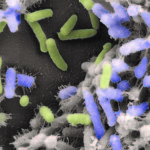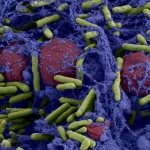Link to Pubmed [PMID] – 22286983
Appl Environ Microbiol. 2012 Apr;78(7):2179-89.
Trimeric autotransporter proteins (TAAs) are important virulence factors of many Gram-negative bacterial pathogens. A common feature of most TAAs is the ability to mediate adherence to eukaryotic cells or extracellular matrix (ECM) proteins via a cell surface-exposed passenger domain. Here we describe the characterization of EhaG, a TAA identified from enterohemorrhagic Escherichia coli (EHEC) O157:H7. EhaG is a positional orthologue of the recently characterized UpaG TAA from uropathogenic E. coli (UPEC). Similarly to UpaG, EhaG localized at the bacterial cell surface and promoted cell aggregation, biofilm formation, and adherence to a range of ECM proteins. However, the two orthologues display differential cellular binding: EhaG mediates specific adhesion to colorectal epithelial cells while UpaG promotes specific binding to bladder epithelial cells. The EhaG and UpaG TAAs contain extensive sequence divergence in their respective passenger domains that could account for these differences. Indeed, sequence analyses of UpaG and EhaG homologues from several E. coli genomes revealed grouping of the proteins in clades almost exclusively represented by distinct E. coli pathotypes. The expression of EhaG (in EHEC) and UpaG (in UPEC) was also investigated and shown to be significantly enhanced in an hns isogenic mutant, suggesting that H-NS acts as a negative regulator of both TAAs. Thus, while the EhaG and UpaG TAAs contain some conserved binding and regulatory features, they also possess important differences that correlate with the distinct pathogenic lifestyles of EHEC and UPEC.



